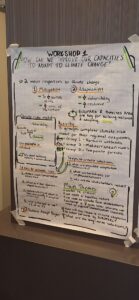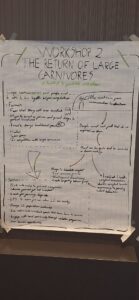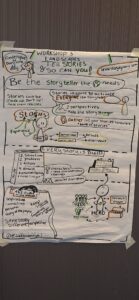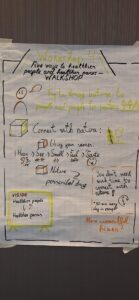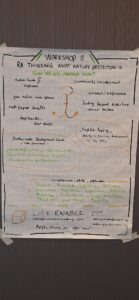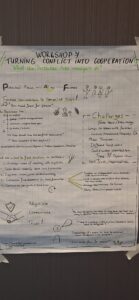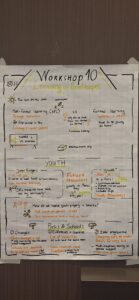Picture by PDF-Grafie for the EUROPARC Federation.
Below, discover all the workshop presentations and outcomes from the EUROPARC Conference 2023 in Leeuwarden, The Netherlands.
Workshop Outcomes – EUROPARC Conference 2023
During three hours, participants had the chance to dive into a topic of their choice to co-learn and discuss with experts. Together, they looked at some of the most burning topics in nature conservation today, to learn how we can create the landscapes of the future. All sessions were joined by somebody from the Youth Core Team, who captured the outputs of the workshop in posters. Below you can find all presentations and workshop outcomes from the EUROPARC Conference 2023.
1. How can we improve our capacities to adapt to climate change?
Led by Marta Múgica, Director, and María Muñoz, Training Programme Officer, EUROPARC-Spain Technical Office and Fundación Fernando González Bernáldez.
Climate Change poses a challenge to all aspects of society, and our protected landscapes are no exception. Adaptation is essential if we want to adequately respond to the impacts that climate change is already causing and will inevitably cause in the future. Have you analysed the opportunities for integrated adaptation in your Protected Area? Are you aware of the particular risks of your area? How and with whom can we design actions to minimise these risks?
In this workshop, participants worked together to analyse risks in different types of Protected Areas; prioritise the needs of the area; identify stakeholders to work with, and propose actions that they can implement when returning to their work after the Conference.
The workshop underlined that, Protected Areas are privileged territories to develop an Ecosystem-based adaptation (EbA) approach. This means using biodiversity and ecosystem services as part of an overall adaptation strategy to help people adapt to the adverse effects of climate change. As these effects becoming ever more apparent, professionals working in nature conservation, need to increase capacities, at personal and institutional levels, to fully include climate change measures into the planning and management plans. Furthermore, those working in Protected Areas, need to work on climate risk analysis. To do so, it is essential to know more about hazards, vulnerability and adaptive capacity of ecosystems and landscapes.
Get the workshop presentation here
2. The return of large carnivores: a toolkit to facilitate coexistence
Led by Federico Minozzi, managing director at EUROPARC Federation. With interventions from Eva-Maria Cattoen, a certified mediator, mediation trainer and managing director of the consulting office “LechtAlps – Ingenieurbüro Cattoen” in Austria, that is specialised in conflict management and public participation processes in the environmental and regional development sector; and Tasos Chovardas is from the EU Platform Secretariat; CALLISTO-Wildlife and Nature Conservation Society and is also a Registered Mediator.
The partial recovery and return of large carnivores in areas of Europe where they have been absent for many years is frequently creating controversy and impacts on rural livelihoods. Protected Areas are likely to be areas where coexistence between human activities and the presence of large carnivores is most threatened.
This workshop helped participants challenge their perspectives and to put themselves in the shoes of their stakeholders. Delegates discussed the role Protected Areas can play to support coexistence. The workshop also presented the new European Toolkit for the establishment of local platforms on large carnivores.
Thanks to the kind support of the Secretariat of the EU Platform for Coexistence between People and Large Carnivores, two experts in environmental mediation and large carnivore management, Eva-Maria Cattoen and Tasos Chovardas, shared their expertise and helped facilitate the discussion.
Tasos Chovardas – Mixed motive template activity
Furthermore, some interesting reading was also shared: A Social Learning Approach for Stakeholder Engagement in Large Carnivore Conservation and Management & Trade-off in the implementation of good practice in large carnivore conservation and management.
3. Landscapes tell stories – and so can you!
Led by Frédérique te Dorsthorst – de Muij of StoryDynamic, workshops trainer, and narrative consultant and narrative coach for individuals, teams and organisations.
How can you turn your personal work-experiences into stories to inspire others? How can storytelling be an approach to protect nature? These questions were the red threads of the interactive inspiration session on the Art of Storytelling.
We are collectively stuck in the story of materialism and financial and economic growth. As a result we have created all the crises we are facing now in the world. The only way to change this is by stepping out of this ‘old’ story and start to tell and share new ones based on the UN Sustainable Development Goals.
The narrative approach in a broader sense, and storytelling as part of it, will support us in changing the stories we tell ourselves and each other.
All human beings are barrels full of stories. Stories about all kinds of situations they have been through in their lives. All these stories together form our identity, both on an individual level, but also as a team, organisation or even as a people. Furthermore, the landscapes of Europe’s Protected Areas contain uncountable stories. Stories about the history of the landscape. Stories about the flora and fauna. Stories about what that landscape means to people, because of special moments in their lives there, or stories from YOUR work in nature. Stories that should be told, because they show the value and importance of these landscapes.
By becoming aware of our own identity as a Federation we will be able to change personally and together our behaviour and therefore act on regional, national and European level.
In this inspiration session about storytelling, participants learned about the basic principles of a good, impactful story. How can nature professionals tell their story? How can they use the power of stories to achieve their goals? Participants to the workshop were given the opportunity to write their own story and discuss the strengths and weaknesses with peers.
Get the workshop presentation here
4. Five ways to healthier people and healthier parks – WALKSHOP
Led by Pete Rawcliffe, EUROPARC Council Member, chair of the HPHPe Commission and Head of the People and Places team in NatureScot and Anna Castelli, EUROPARC Directorate Support to the HPHPe Commission. The practical exercises were also led by two other HPHPe Commission Members: Sanna Kaisa Rautio, Senior Specialist, Recreational Amenities, Metsähallitus, Finland and Liesbeth Van Gysegem, Regional Landscape Kempen and Maasland.
The SDG framework provides a supportive framework for enabling both Healthy Parks and Healthy People. By using practical experience from a range of Parks and Protected Areas, this interactive workshop explored what is holding us back from realising the potential of Protected Areas as natural health centres. Realising this potential can restore our need for harmony, as it underlines the importance of natural areas for our mental and physicial health.
In this “Walkshop” participants went outside to experience the 5 ways to well-being approach in practice, share experience of its use by Protected Areas and discuss the challenges to embedding this work into the everyday work of health and nature professionals. The 5 ways to well-being approach is an evidence-based action, that has a wide variety of possible applications. It consists of:
- Be active;
- Take notice;
- Give;
- Connect;
- Learn.
The approach can be adapted to the individual or group needs and expectations. It should however, wherever possible, consist of three separate and equal parts:
- A low impact exercise;
- A Social Session;
- A conservation/nature activity.
The walkshop also underlined the importance of evaluation after organising nature health activities. The health sector will need to see evidence of the impact of the activities or excersises. As such, evaluation is essential.
Get the workshop presentation here
5. Re-thinking what nature protection is: how do we market hope?
Led by Neil McIntosh, Project manager of the LIFE ENABLE project at EUROPARC and Sandra Grego, LIFE ENABLE Project Officer and Communications Assistant.
To make a real difference in how nature is valued & protected, Protected Area Managers need to champion an ambitious vision of what we hope to achieve. Our vision will determine how we have to work now, for the future. Sustainable management of nature requires Protected Area managers to become social engineers. Can we think of Protected Area Managers as nature’s social workers?
Even if we know what to protect and how, protection is not in itself enough. To be effective advocates for nature, new approaches are necessary. To achieve more for nature, we all need to work towards the ‘bigger picture’. This requires nature’s needs to be clearly communicated, shared and owned by the whole of society. To achieve our ambitions for nature, we need to invest now in competence-based actions that connect people and place.
As such, empowering Nature Professionals in their everyday work is the most logical solution for everyone’s benefit.
To that end, LIFE ENABLE is creating the European Nature Academy, a tailor-made training hub designed to help managers achieve their priorities for nature. The Academy offers learning programmes focused on core competencies for all nature management practitioners. The aim of this project is to enable all Natura 2000 and Protected Area managers, to become more effective, competent and confident nature management professionals.
With this platform, we want to encourage lifelong learning and continuous development for Nature Managers through capacity building. Building on versatile tailor-made training courses, participative workshops and face-to-face events, the project aims to empower the next generation of effective Nature Managers who will share the LIFE ENABLE legacy in their own areas of work.
6. Nature in the digital age. How can we use technology in conservation?
Led by Fernando Pinillos Communications and IT Officer at the EUROPARC Federation.
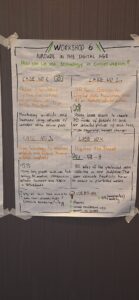
Outcomes poster created by the Youth Core Team. Click to enlarge!
Technology has become a fundamental component of nature conservation. It allows us to acquire a deeper understanding of nature, better assess the impact of our interactions, forecast changes in natural processes and resources availability and collect, process and store data in a manner that was previously unattainable. New technologies are increasingly a solution to maximize staff efficiency and improve management of Protected Areas at different levels. However, the necessity to count with specific knowledge to develop or utilise these tools, the overwhelming amount of existing resources, the lack of experience and other limiting factors, often condition our capacity to take a step forward and incorporate technological solutions into our work. It is therefore essential, to improve the exchange of experiences in order to facilitate the application of technologies in Protected Area management. There is a big gap of knowledge on the options, implementation and operation procedures
That is why, this workshop, provided participants with the opportunity to share and learn from each other about how technology has eased the work carried out in managing Protected Areas, protecting or restoring nature. Hartmut Wimmer of Digitize the Planet presented the work that his organisation is doing in collecting data on Protected Areas regulations, laws and agreements that govern behaviour in natural areas. The information follows a standardized data format and is delivered through other applications, such as outdooractive.com, in order to keep Park visitors informed at all times. Furthermore, Cladiu Iușan and Mihaela Poll of the Rodna Mountains National Park in Romania, presented their online monitoring system for nature conservation, and Myrthe Fonck of PWN introduced how they are using techonology to monitor human-wildlife interactions and reduce conflicts. Additionally, Vanessa Berger, senior researcher and project manager at the UNESCO Chair at FH Kaernten, gave participants a glimps into the BioMONITec project that uses Artificial Inteligence in nature conservation.
Hartmut Wimmer – Digitize the Planet
Cladiu Iușan and Mihaela Poll – Rodna Mountains Online Monitoring System
Myrthe Fonck – PWN Human-Wildlife monitoring
Vanessa Berger – UNESCO Chair FH Kaernten – BioMONITec project
7. Turning Conflict into Cooperation: What can Protected Area managers do?
Led by Stefania Petrosillo, Policy Officer of the EUROPARC Federation, Bernard le Roux, co-founder of Dialogues AB, a company dedicated to working in the field of tension surrounding complex issues – both within the public and private sectors, and João Cardoso de Melo, Director of Cascais Ambiente and EUROPARC Council member.
Managing a Protected Area where local communities live and work, requires good skills on conflict prevention and management. That is especially true speaking about farming in and around Protected Areas. The session offered Protected Area managers, suggestions, approaches, techniques and inspiration to improve their capacities to manage conflicts. With increased polarisation on the European political landscape, a dialogue-mindset and skillset is the most effective way of dealing with the complexity of the issues Protected Area managers face.
From the workshop it became clear that it is possible to collaborate. History and culture need to be taken into account. Independent facilitation may be necessary in polarised situations. Safe spaces for deep dialogue needs to be created. Managers need to clearly frame the dialogues. For that, good negotiation skills are needed. Honesty, relationship, time and realistic goals are essential.
It is important to gather and create examples of successful collaborations. That is why, capacity to deal with tension and complexity needs to be built. Authorities need to realise that building relationships with local actors is essential. Simple solutions, imposed from the top, only add to the tension. We need to develop a strategy and provide managers and decision-makers with the understanding and tools to think and act collaboratively.
8. Recreation management: How involving user groups in co-decision-making processes can help create more effective regulations.
Led by Teresa Pastor, European Charter for Sustainable Tourism Manager at the EUROPARC Federation, Marieke Kuipers, senior advisor recreations at PWN and Urs Wegmann, Managing Director of the Greifensee Foundation and member of the board of the Griffin Ranger Company.
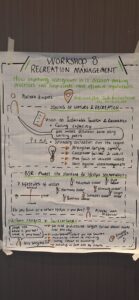
Outcomes poster created by the Youth Core Team. Click to enlarge!
Protected Areas, in general, and Periurban Parks, in particular, have seen a huge increase in the number of users and types of recreational activities and outdoor sports. Quite often, the latter impact nature and on other users. Thus, one of the main challenges park managers are confronted with is the quest for a balance between nature conservation and hosting visitors.
However, how can Park managers respond if rules are not respected? Is the implementation of strong restrictions an uncomfortable, but urgent, measure for the benefit of both nature and people? Or should managers involve user groups in co-designing the rules as to ensure better compliance? How can rangers support this process? Participants in this workshop learned from the experiences of the Zuid-Kennemerland National Park in the Netherlands, as well as from Swiss rangers who specialise in recreation issues near cities.
From the workshop it became clear that cooperation among administrations is key. In order to distribute visitors better, and in a more harmonious way, in the Amsterdam region and take out some pressure on the National Park, authorities in the Amsterdam region are working on regional levels to find other natural alternatives to offer to citizens, closer to their homes.
In the past, there was not a structural vision of the landscape at a high scale. It is essential that landscape managers work more in a structured, cooperative way, at a larger scale. Having a forward thinking approach is important, as well as an environmental impact assessement to understand the consequences of the modifications we introduce in the landscape for the ecosystems and species that live there.
Case study: Marieke Kuipers PWN Visitor Management Zuid-Kennemerland
Urs Wegmann, Urban Rangers in Switzerland
9. Identifying enabling factors for effective Protected Area governance and promoting innovative funding opportunities to improve connectivity.
Led by Evelyn Underwood, Head of programme, Biodiversity and Ecosystem Services at Institute for European Environmental Policy, and Gabrielle Aubert, Policy Analyst, Biodiversity and Ecosystem Services at Institute for European Environmental Policy.
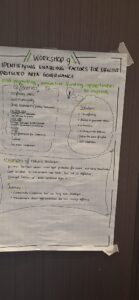
Outcomes poster created by the Youth Core Team. Click to enlarge!
In this workshop, participants jointly analysed different governance frameworks of Protected Areas and identified the enabling factors as well as challenges for conservation planning. Small groups investigated traditional and innovative funding opportunities for a resilient network of Protected Areas, including Natura 2000. Specific examples from different countries were used to highlight success stories, learn from others and shed light on other, often overlooked funding mechanisms, with the goal of pointing out existing funding opportunities for Natura 2000 and other Protected Areas in different contexts, and learn how to identify which are best fitted to your reality and country.
Ecological connectivity is essential to facilitate the movement of organism across the landscapes. Furthermore, ecological corridors can support many other services such as carbon sequestration and recreational spaces for people.
In order to improve conservation planning, we need to improve dialogue across administrative levels and sectors, we cannot continue working in silos. Legal frameworks are essential. However, often they are not being followed or not effectively implemented.
We should address connectivity from a landscape perspective, it is not only the parks and conservation agencies responsible but all other sectors who are present in the wider landscape. For this we need to work better together, across sectors and levels. Legal frameworks are really important and the foundation for the implementation.
10. Learning in landscapes
Led by Jessica Micklem-Kolenic, Youth Officer at the EUROPARC Federation, Leonardo Cerno, Youth Representative at the EUROPARC Council and the Youth Core team of the Conference.
Protected Areas are a bridge between nature conservation and local communities through non-formal education as well as partnerships with schools. To achieve the SDG we need non-formal learning and Protected Areas are a great place for hands-on-learning for young people and for all ages. To connect this to a larger scale, Parks are welcome to participate in EUROPARC’s Youth in Parks Day. During the workshop, participants collected ideas for activities with different target groups. There are various programmes connecting young people with landscapes. Across countries there are many similarities such as an increase in acknowledgement of the importance of environmental education. Some examples are Italian “Blue week” connecting young people to bodies of water or “green week” in Romania that takes children out into national parks.
11. Sustainability and Environmental Education in Outdoor Sports
Led by Benjamin Billet, Head of Policy at ENOS, the European Network of Outdoor Sports.
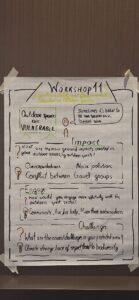
Outcomes poster created by the Youth Core Team. Click to enlarge!
Outdoor sports can have impacts on nature, but they are also impacted by climate change and degradation of natural environments. Therefore, it is essential that outdoor sports are on the forefront of supporting sustainable development. Outdoor sports provide ample opportunities for connecting people to the landscape.
During this workshop, educational materials developped with in the SEE Project were presented. These outputs of the SEE project are aimed at outdoor sports training providers, but could also be a helpful resource for park managers and (nature) guides that organize excursions or running tours.
The SEE toolkit provides educational resources for outdoor sport training providers and other educators to make sure that outdoor sports are being practised in harmony with nature. Through various exercises and teaching methods, trainers, instructors, or guides are being enabled to raise awareness for sustainability issues, rethink mobility, inform people about the possible impact of outdoor sports (and how to mitigate these), integrate environmental education in outdoor sports and motivate outdoor sports practitioners to become change agents.
During this workshop, the aims, and results of the SEE project were be briefly presented, including some good practices that show how outdoor sports organizations and practitioners can also be advocates for nature protection. The second part of the workshop included actual testing of various methods and exercises of the SEE toolkit by the attendees.
12. Landscapes of the future – what is needed for effective Protected Area management?
Led by Tim Duckmanton Team Leader, Strategy and Environment, Lake District National Park Authority and Matti Tapaninen, EUROPARC Nordic-Baltic Section, and Senior Advisor at Metsähallitus.
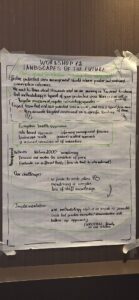
Outcomes poster created by the Youth Core Team. Click to enlarge!
Protected Areas now cover over ten percent of the world’s surface, and the Convention of Biological Diversity sets new ambitious targets for conservation. The Key question for the future is to understand better how effective we are in the management of Protected Areas and other natural and cultural settings. Management effectiveness evaluation is defined as the assessment of how well Protected Areas are being managed – primarily the extent to which management is protecting values and achieving goals and objectives. Evaluation of management effectiveness is recognized as a vital component of responsive, pro-active site management. As well as being an essential tool at local, regional and national level, evaluation also has an increasing international context. Members of the EUROPARC Federation have a growing need for better guidance and tools to evaluate management effectiveness.
This workshop offered participants with a good understanding of the role of management effectiveness evaluation, how it can be used at different scales at a system, network or site based level. Furthermore, it established what support Protected Areas need to implement appropriate models of management effectiveness evaluation. This includes:
- Development of a good methodology;
- Open access to data from other areas;
- Adaptive management;
- Realistic timeframes for evaluations;
- Evalution on country level;
- Stakeholder engagement with parties outside of the Protected Areas.
This session reviewed cases studies from Finland, Germany and Czech Republic, from a site and system perspective. It showcased the many scales and methods that are available, and how these relate to the Montreal CBD targets, work of the IUCN World Commission on Protected Areas and the facilitating role of the EUROPARC Management Effectiveness Commission. Participants also exchanged on their own experiences and challenges delivering management effectiveness.
We thank all workshop leaders for sharing their expertise and making these workshops a success!
